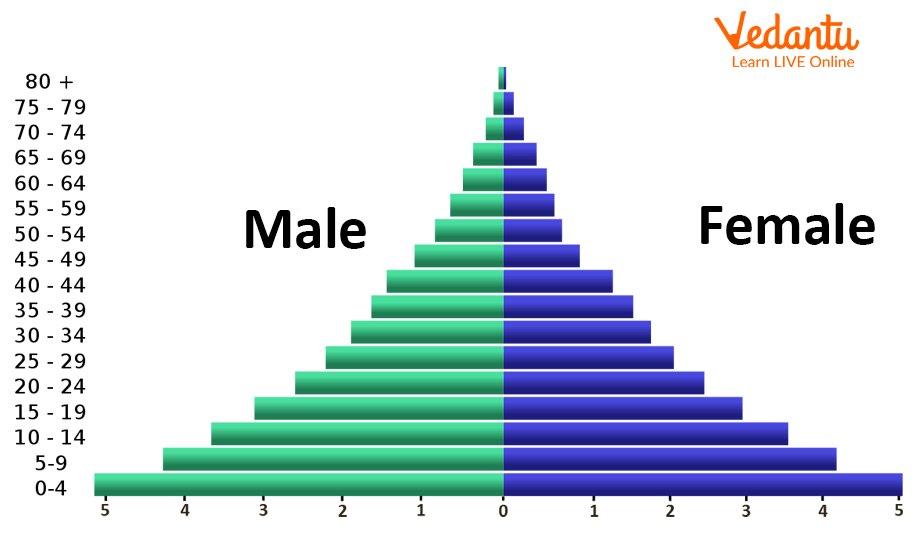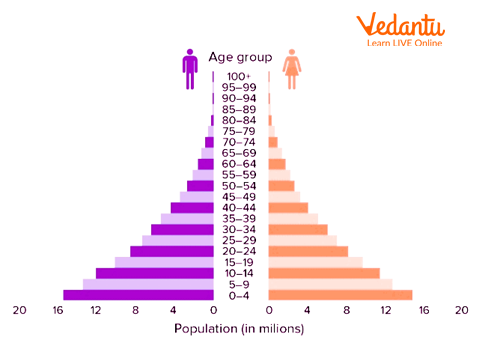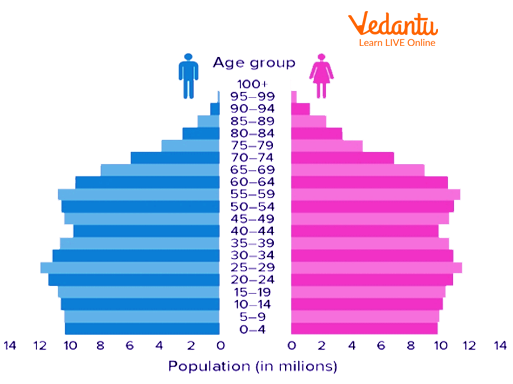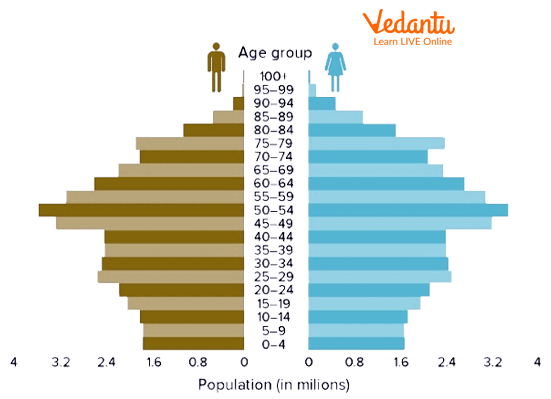How does a population pyramid help us understand the population structure of a country?
The population pyramid is a powerful graphical tool in biology and demography. It visually represents the age and gender distribution of a population at a specific point in time. Understanding population pyramids helps scientists, policymakers, and even UPSC aspirants assess population trends, predict social needs, and plan for the future effectively.
What is a Population Pyramid?
A population pyramid is a bar graph that displays the structure of a country’s population by age groups and sex. The left side shows males, while the right side shows females. Each horizontal bar represents a particular age group, with the length reflecting the population size of that group. Population pyramids are essential in studying demography, societal ageing, and understanding workforce trends.

Structure and Features of a Population Pyramid
A population pyramid typically consists of two mirrored vertical bars—one for each sex. The vertical axis denotes age groups, usually split into five-year intervals. The horizontal axis shows the population percentage or actual numbers. The shape of the pyramid reveals the population's growth rate and highlights phenomena such as birth rates, death rates, and life expectancy.
- Broad base: Indicates high birth rates.
- Narrow top: Indicates lower life expectancy.
- Bulges or indentations: Show unique events (wars, baby booms).
- Sex ratio: Gender distribution for each age group.
For more insights into population and demographics, explore the Malthusian theory of population growth on Vedantu.
Types of Population Pyramid
Population pyramids are generally classified into three major types based on their shapes, each reflecting a different demographic scenario. Understanding these types is important for comprehending the population dynamics of various countries.
1. Expansive (Expanding) Population Pyramid
Expansive population pyramids have a broad base and narrow top, indicating a large proportion of young people and high birth rates. These are typical of developing countries with rapid population growth, such as parts of Africa and South Asia. The pyramid quickly tapers upwards, showing fewer older individuals due to higher mortality rates.

2. Stable (Stationary) Population Pyramid
The stable population pyramid, also known as a stationary pyramid, has nearly equal numbers in most age groups, giving it a bell or rectangular shape. Birth and death rates are low, typical of developed countries like the USA. This shape suggests stable population growth and balanced sex ratios across age groups.

3. Constrictive (Declining) Population Pyramid
A constrictive or declining population pyramid has a narrower base than the middle, indicating low birth rates and an ageing population. Seen in countries like Japan and some European nations, it reflects longer life expectancy and challenges such as shrinking workforce and higher dependency ratios.

Population Pyramid of India: Trends and Analysis
The population pyramid of India is an excellent example of the expansive type, though it is gradually trending toward a more stable shape. Young people make up a large proportion, with slow but visible increases in the elderly sections due to improved healthcare and rising life expectancy. The India population pyramid 2024 and projections for 2025 show this demographic transition.
- India’s base is wider—high percentage of youth and working-age groups.
- Gradual narrowing at the top reveals a growing, but still small, elderly population.
- Sex ratio at birth is slightly skewed, which policymakers observe closely.
Understanding the causes and effects of overpopulation is crucial for grasping India’s challenges and planning for the future.
Significance and Applications of Population Pyramids
Population pyramids are more than just diagrams—they provide deep insights into a country's social, economic, and health needs. Governments, the United Nations, and researchers use them for:
- Forecasting future demands in education, jobs, and healthcare.
- Planning pension and social security systems as populations age.
- Understanding patterns in fertility and mortality rates.
- Identifying issues like a declining or rapidly growing population.
- Allocating resources in sectors such as agriculture or environmental management.
For more on how climate and the environment impact population structures, read about the effects of climate changes.
Population Pyramid and Sex Ratio
The sex ratio in a population pyramid shows the balance between males and females in each age group. Balanced or imbalanced sex ratios help predict social trends, identify possible future labor shortages, and aid in policy creation. In India, efforts to balance the sex ratio at birth and improve women’s literacy are closely related to achieving sustainable population stability.
How Population Pyramids Explain Demography
Demography is the scientific study of populations. Population pyramids explain the stages of population growth—expanding, stationary, and contracting. By interpreting a country's pyramid, you can:
- See if the population is growing, stable, or shrinking.
- Understand the potential for population momentum due to youth numbers.
- Assess the burden of dependents (young and old) on the working-age population.
- Plan for future needs, from education to elderly care.
If you’re eager to learn the difference between acquired and inherited traits, population pyramids can also reveal how such traits might spread in a population over time.
Comparison: Population Pyramids of India, Japan, and the USA
| Country | Pyramid Type | Key Features |
|---|---|---|
| India (2024/2025) | Expansive | Broad base, many young people, gradually increasing elderly population, high population growth |
| Japan | Constrictive | Narrow base, large elderly population, low birth rates, shrinking workforce |
| USA | Stable/Stationary | Even distribution across age groups, moderate elderly percentage, low but stable growth |
This table highlights how different countries are at different demographic stages, influencing their economic and social policies.
Conclusion and Real-World Implications
Population pyramids are central to planning in healthcare, education, environment, and economic development. They influence policies in medicine, agriculture, and even disaster management. Whether studying the India population pyramid for 2024 or forecasting for countries like Japan or Kenya, these diagrams powerfully explain a nation’s story in numbers—and help shape a sustainable, equitable future.
Want to widen your biology knowledge? Browse more expertly written resources at Vedantu, from life science to food science and beyond.
In summary, the population pyramid is an essential demographic tool. Its ability to display trends, compare different regions (like the population pyramid of India, Japan, or the USA), and guide vital policies makes it invaluable for students, researchers, and policymakers alike.


FAQs on Understanding the population pyramid and its types
1. What is a population pyramid?
A population pyramid is a graphical representation that shows the age and sex distribution of a population. It helps illustrate demographic trends and population structure at a glance.
- Shaped like a pyramid with males on the left and females on the right
- Each horizontal bar represents a specific age group
- The length of the bar indicates the population size of that group
- Wider bases show high birth rates, narrow tops indicate lower life expectancy
- Important for demographic analysis and planning
2. Why are population pyramids important in geography?
Population pyramids are crucial in geography because they provide a quick visual summary of a region’s demographic structure.
- Help compare countries' or regions' population growth and decline
- Identify age dependency ratios
- Guide resource allocation for education, healthcare, and jobs
- Support planning for future social and economic needs
- Assist in policy-making and predicting population trends
3. What information can we learn from a population pyramid?
A population pyramid reveals key details about a population’s age and gender composition.
- Birth and death rates
- Proportion of young, working-age, and elderly people
- Gender ratio in different age groups
- Potential for population growth or decline
- Social and economic challenges ahead, like ageing population or youth bulge
4. What are the main types of population pyramids?
There are three main types of population pyramids, each reflecting a different demographic situation.
1. Expansive Pyramid: Broad base, indicates high birth rates and rapid population growth.
2. Constrictive Pyramid: Narrow base, shows declining birth rates and ageing population.
3. Stationary Pyramid: Even width throughout, stable population with low birth and death rates.
5. How do you read and interpret a population pyramid?
To interpret a population pyramid, analyze the shape and proportions of each age group.
- Wide base: High birth rate, youthful population
- Narrow base: Low birth rate, ageing trend
- Symmetry shows equal male and female populations
- Bulges/dips indicate migration, war, or epidemics impacting specific groups
- Top heavy: Ageing population, greater dependency ratio
6. What can an expansive population pyramid tell us about a country?
An expansive population pyramid indicates a country with a high birth rate and rapid population growth.
- Large proportion of young people
- Pressure on education and health services
- Possible future increase in workforce
- Often seen in developing countries
- May need investments in child and maternal health
7. What societal problems can be identified from population pyramids?
Population pyramids reveal age-related challenges that affect society.
- Youth bulge: Need for more schools, jobs
- Ageing population: Higher demand for elderly care
- Imbalanced gender ratios: Social issues
- Sharp dips: Impact of past wars, diseases, or migration
8. How does a constrictive population pyramid differ from an expansive one?
A constrictive population pyramid has a narrow base, showing fewer young people, while an expansive pyramid has a broad base, indicating many young individuals.
- Constrictive: Low birth and death rates, stable or declining population, ageing society
- Expansive: High birth rates, high death rates initially but declining, young population
9. How are population pyramids useful for government planning?
Population pyramids help governments plan for resources and policies by highlighting demographic trends.
- Forecast needs for schools, healthcare, and jobs
- Plan for pensions and elderly care
- Identify regions needing development
- Prepare for future population changes
10. What does a stationary population pyramid indicate?
A stationary population pyramid indicates a stable population with balanced birth and death rates.
- Similar-sized age groups throughout
- Low population growth rate
- Common in developed countries
- Indicates sustained social and economic stability
11. What factors can cause changes in the shape of a population pyramid?
Various factors like birth rates, death rates, and migration can alter a population pyramid.
- High or low fertility rates
- Changes in mortality due to epidemics or improved healthcare
- Large-scale migration
- Government policies affecting population growth
12. How does migration affect a population pyramid?
Migration can change the shape of a population pyramid by altering the age and sex structure.
- In-migration: May increase working-age groups
- Out-migration: Can reduce youth or working-age population
- Gender imbalances can occur if migration is male-dominated










